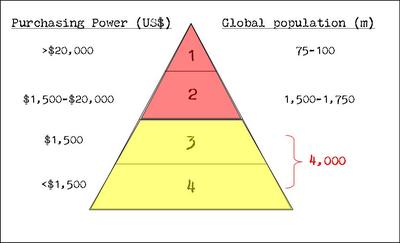Last month, I had the opportunity to travel to Colombia for school to work on a consulting project (see my previous post about Colombia here). We were focusing our work on the bottom of the pyramid (BOP), which typically means the poorest sectors of society. In business schools today, growing attention is being paid to this sector and the influence they are having on economies. Characteristically, this is the segment of the population habitually ignored in traditional business models because they are often thought to be too poor to contribute to the greater economic sector.
of society. In business schools today, growing attention is being paid to this sector and the influence they are having on economies. Characteristically, this is the segment of the population habitually ignored in traditional business models because they are often thought to be too poor to contribute to the greater economic sector.
I am happy to see that this perspective of doing business is changing. The project I was working on targets poor populations in Colombia, and incorporates the technologies they are already using as a revenue-generating platform. Without being able to discuss it too much, a business model was created to convey information to cellular telephones that not only will help the people who subscribe to the text messages, but also provide a service they are willing to pay for. The positive impact will be had for both the individuals receiving the information, but it will also be a profit-raising endeavor for this company.
Usually this demographic of the BOP lives on less than $2 a day, and have a much more limited capacity to interact in global markets. However, I argue that creating a business that targets the BOP is important for a number of reasons.
First, I think it is important to initially recognize that these people exist and can contribute to a system greater then their immediate community. This provides validation for those individuals because not only does it recognize that they are engaging, but also offering a choice to do so. By offering the option to engage in a market or not is important, as opposed to the greater market making the decision for them.
Second, I argue that it utilizes untapped brain power to empower typically neglected people who may have great insight towards new and innovative ideas. The BOP and the consumer typically know what they need to make life easier, and often will have an idea as to how best to overcome the everyday obstacles. If corporations were to approach communities to seek out products they needed (or ways to improve existing products tailoring them towards this market) then we will see benefits for both parties.
Third, targeting the BOP opens new and expanded market opportunities. If a company can effectively infiltrate an expanding market, one not already saturated then they will have a leg ahead of future competition as potential incomes rise. Many development philosophers would argue that working on the ground to find solutions to aid issues is important before scaling up a project. The same would be true for the BOP market, once you can target this demographic, you can spread outwards and upwards with an idea.
A great book on this topic is C. K. Prahalad’s The Fortune at the Bottom of the Pyramid. In it, he argues that we can eradicate poverty through profits.
This seems like a far-fetched idea to those typically involved in non-profit organizations working to eradicate poverty through foreign donation and volunteer work. Instead Parhalad argues for redesigning the conventional models of business to attack the 4 billion poorest people in the world because they represent a significant portion of the market. I don’t know if I agree that this approach will eradicate poverty singlehandedly only because I will imagine that the first companies to undertake this will be consumer goods previously targeting more expendable incomes. However, I agree it will be a significant step.
I read this quote about the BOP philosophy and how it relates back to our traditional version of helping the poor.
The market creation approach aims to go beyond just exploiting BOP markets. It is acknowledged that markets do not initially exist for safe water, sanitation, reforestation and mosquito nets. These markets must be created by public investments: the private sector can not invest in public health or other development domains such as hygiene awareness, malaria prevention or organizing small farmers into viable production units. As the purchasing power of poor people is indeed very limited, smart subsidies may be needed to reach the poorest and most vulnerable groups.
While yes I agree that we will still need as much aid and outside help to continue the work of eradicating poverty, I argue that this is another important philosophy to begin employing as we move forward. Offering purchasing power is a luxury that we experience every day, now its time to make this opportunity accessible to 4 million more people.
–Katherine Peterson is a Program and Research Intern with the SISGI Group focused on theories of development, globalization, and political ramifications of development work.


